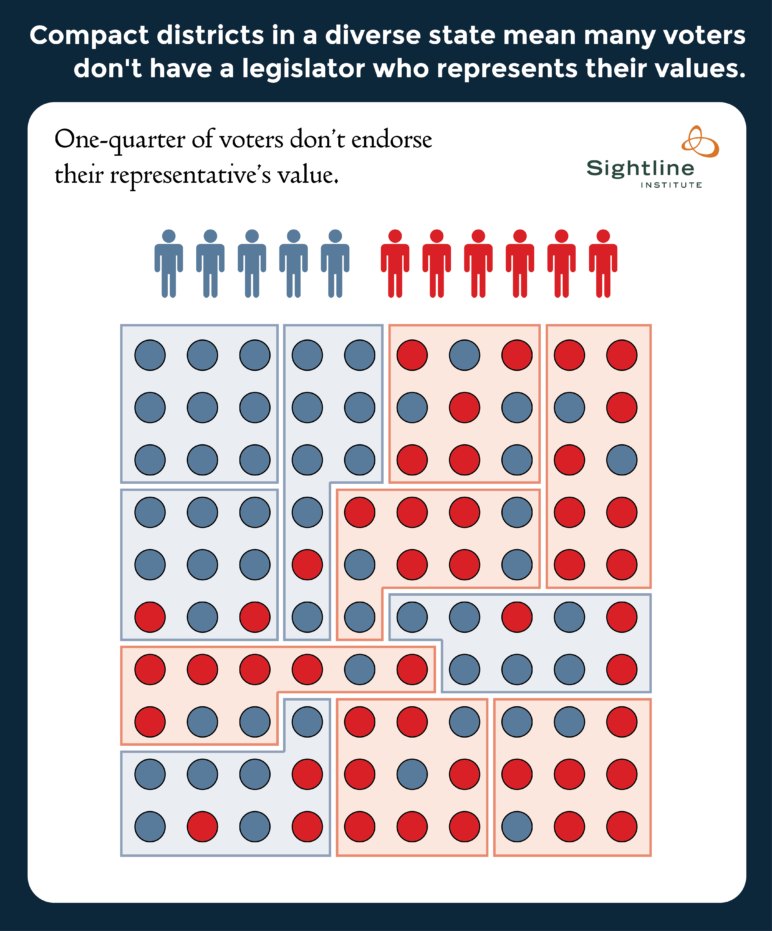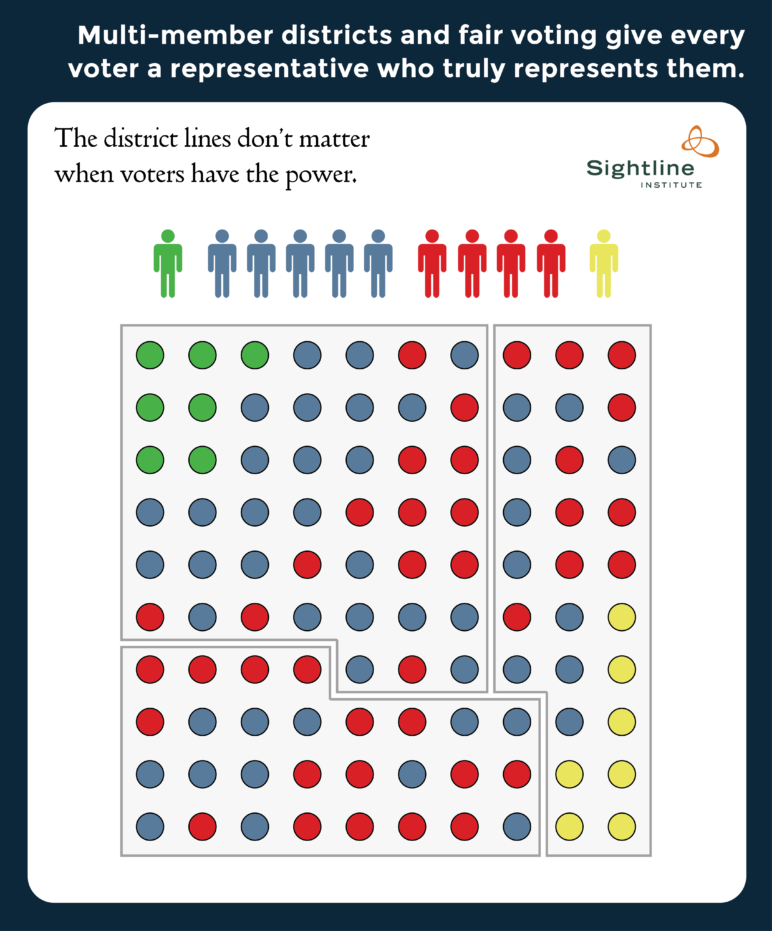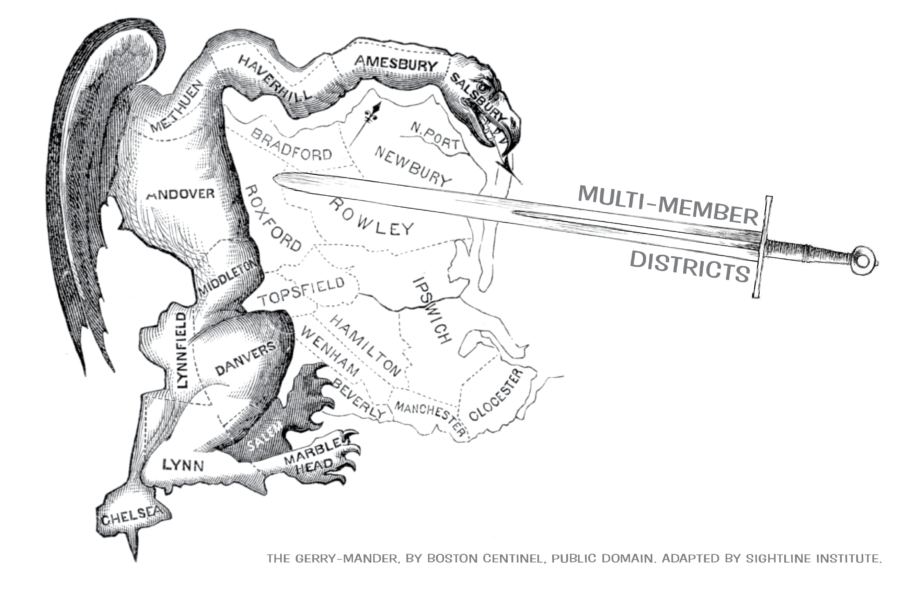Author’s note: This is a summary of a four-part series called “Slaying the Gerrymander.” You can read the full series here: Part 1, Part 2, Part 3, and Part 4.
Let’s say you are a governor and you want to end gerrymandering in your state for good. You believe in representative democracy—that voters should choose their representatives, rather than politicians choosing their voters. You’ve heard of nonpartisan and bipartisan redistricting commissions and computer algorithms, but you’ve also heard that voters’ self-sorting might bias the maps, no matter who draws the lines. What should you do?
You should ask an independent commission to draw multi-winner districts and use a fair voting method. Proportional representation is the only way to guarantee voters wield equal power and win fair representation.
Think of the legislature like beer, not baseball
You might be thinking of political races like sports matches. “One team wins, the other loses. That’s just life.” This analogy works when electing a president or governor—only one candidate can win. But electing a legislature is more like ordering a bunch of beers for a group of people watching the baseball game. If each table is only allowed to order one kind of beer for the whole table, half or more of the people at the table won’t get a beer they like. That’s not just life. It’s a silly way to order beer.
Instead, each table or group of tables could order three or four kinds of beer. Now all pale and dark drinkers will have access to a cold one they like, no matter which table they’re at. And, given more than two options, maybe enough people want a lager or a honey ale and they could share a pitcher between them.
Patrons in a one-beer-per-table establishment will get annoyed, and voters in a single-winner-district might start to lose faith in representative democracy. But you could use multi-winner districts and fair voting methods to give voters the power to elect a representative they want, no matter where they live.
Voters’ values should matter more than their geography
Single-winner districts guarantee just one type of representation: geographical. Every voter knows she has one representative in the legislature with a home address not too far from her. But in a complex and diverse state, that might not mean much. Living in the vicinity gives no guarantee that a candidate shares a voter’s values, worldviews, and priorities.
Both conservatives and progressives live in every neighborhood and region, meaning a local representative can’t possibly represent all local voters’ values. Imagine your state has 100 voters, 54 of whom lean Democratic and 46 percent lean Republican. Voters elect an 11-member legislature. An independent commission or a computer algorithm draws 11 districts as compactly as possible. Democratic voters tend to live in the urban area of the state and elect like-minded legislators, but even so, 30 percent of Democratic voters end up represented by Republican legislators, while 20 percent of Republican voters are represented by Democrats. Not only that, but Republicans will dominate the legislature even though most voters are Democrats.

Ironically, the only way for you, Mr. or Ms. Governor, to give more voters in your state the power to elect a legislator they like is to gerrymander the lines. Imagine the same state with the voters living in the same places, but now you order the redistricting commission to draw crazy-shaped districts to group like-minded voters together. In this hypothetical state, a commission or computer could ensure that 89 percent of voters have a representative they agree with. The legislature overall will reflect the voters, but a few voters still get left out, and the map won’t be pretty.

You wanted to get away from gerrymandering, but your attempt to give voters a voice in single-winner districts has led you right back to gerrymandering! What’s a governor to do? Abandon single-winner districts in favor of multi-winner districts and fair voting.
Voters want to see themselves reflected in their representatives
Single-winner districts ensure geographical diversity, but will a geographically diverse legislature also reflect voters’ diversity in terms of race, class, gender, and life experience?
Clearly not. The United States and Canada both prioritize geographical diversity by using single-winner districts, and as a result they rank number 100 and 63 in the world, respectively, in the percentage of women who hold office in their national legislatures. Rwanda, Nicaragua, Mexico, South Africa, Namibia, and other countries using multi-member districts all have more than 42 percent women legislators, compared to 19 percent in the United States and 26 percent in Canada.
Your state could join the many jurisdictions with more diverse and reflective governing bodies by using multi-winner districts and proportional voting methods.
Give all voters equal voice, no matter where they live
Prioritizing geography above all else has another sinister side effect: it makes some voters more powerful than others. This result violates the principle of “one person, one vote,” but it is an unavoidable bug of single-winner districts, no matter who draws the lines.
Unequal voting power plays out in two main ways. First, in the United States, single-winner districts systematically give conservative suburban and rural dwellers more voting power than progressive urbanites. Candidates in dense urban districts win by higher margins, giving those voters less power per voter to elect a representative, compared to more conservative voters dispersed across many districts with closer margins.
Second, most districts are “safe” for one party or the other, meaning the real race is the partisan primary. In a “safe” Democratic district, two Democrats face off in a fierce primary fight, and whoever makes it to the general election is assured victory. In effect, partisan primary voters (who tend to be older, whiter, and more conservative than the general population) have a say in who wins but general election voters’ voices don’t matter. Even in a state such as Washington that uses nonpartisan, “top-two” primaries, usually one candidate from each major party makes it to the general, where the candidate from the dominant party is all but guaranteed the victory. In ‘top-two” districts that lean overwhelmingly towards one party, two candidates from that party might make it to the general, giving general election voters a chance to weigh in on a real race.
You, the governor, could implement multi-winner districts and proportional representation to make sure a voter is a voter, no matter where she happens to live.
Choose any of these fair voting methods
There are many candidate-centric proportional methods. Here are three you could consider, and how they might work with five districts that are combined together into a single five-winner district:
- Ranked ballots. Instead of seeing (probably) just two candidates on the general election ballot, and filling in a bubble for one of them, voters see more candidates on the ballot, perhaps ten, and get to rank them. The top five win seats.
- Cumulative ballots. Voters can distribute three votes as they want—giving all three to one favorite candidate, for example, or giving one to each of three candidates. The five candidates with the most total votes win seats.
- Open List ballots. Ten to twelve candidates are listed on the ballot by party. Voters can vote for any candidate. The top five candidates win, and each party wins a share of seats proportional to its share of votes.
Imagine again that hypothetical state with the same 100 voters. Instead of ordering a commission to draw 11 single-member districts, you ask it to draw three multi-member districts with one of the voting methods described above. Voters who previously felt forced to vote for “the lesser of two evils” between the two major parties might now express their true preferences for the Greens or the Libertarians. And every single conservative voter and all left-leaning voters would have at least one representative who thinks as they do, no matter what part of town they live in.

Break free from the single-winner trap
You could spend the rest of your career trying to find the right commission or mathematical formula to draw lines that will give voters a voice, and you’ll go to the grave wondering why it never worked. But if you shake off the idea that each district should have just one representative, you can immediately improve representative democracy in your state. With more than one winner per district, and a fair voting method, all voters will wield equal power and win fair representation.
[list_signup_button button_text=”Like what you|apos;re reading? Get our latest democracy research right to your inbox.” form_title=”Reclaiming Our Democracy” selected_lists='{“Reclaiming Our Democracy”:”Reclaiming Our Democracy”}’ align=”center”]

 Stay Informed
Stay Informed
Comments are closed.